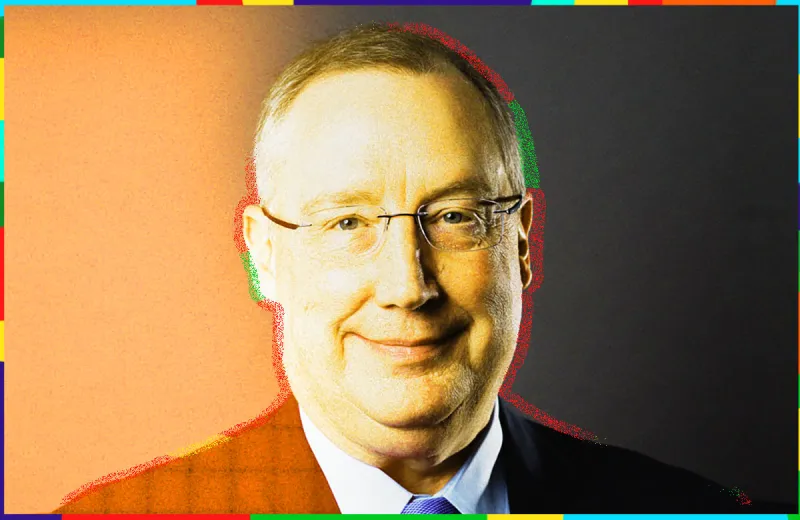
Courtesy photo
The downturn into a bear market wasn’t the only challenge Exelon investment chief Doug Brown faced that February.
The chilly Chicago month also brought change to Exelon’s $51 billion investment portfolio: It split into two separate entities, following in the footsteps of the energy giant’s parent companies.
Brown and his team spent the following months juggling a stock market slide, rising interest rates, and inflation, all while separating assets with a smaller-than-usual staff thanks to the split.
But Brown wasn’t worried. After all, he had led the team from its start in 2009, building a new investment staff, then seeing it through a market recovery, internal tragedies, and the Covid-19 pandemic.
“He is a level head in times of chaos,” says Andy Ward, University of Chicago CIO and Brown’s one-time mentee. “He does not get rattled; he’s very grounded.” Adds Francis Idehen, COO at Grosvenor and a former Exelon employee: “He’s consistent. He’s warm. He’s kind.”
Colleagues and industry peers alike say that Brown’s calm, collaborative leadership style has driven the CIO’s success in the industry. But Brown didn’t start out as a leader — he learned on the job, first at Chrysler, then while rebuilding Exelon’s investment office from scratch.
“I’d always been interested in markets and investing,” he says. “I ultimately became the head trader, which was kind of my first true market experience. It was great. I was hooked after that.”
Though formative, this time was also humbling for Brown. The currency market operated on a 24/7 basis, as it does today. But back then, according to Brown, it was like the “Wild West.”
He explains, “Early on, I think I was caught up and overreacted, and I learned to take a much more measured approach, which I think has served me well.” Brown worked his way up through the ranks, eventually becoming the firm’s chief investment officer. “It was a fabulous place to work,” he says.
By 2008 — after nearly 26 years at Chrysler — Brown was ready for a change. So was Exelon.
The energy company’s portfolio, despite being well funded, wasn’t prepared for the global financial crisis. With a small team and a consultant-driven model, the pension fund didn’t have a significant allocation to alternatives — or much diversification. The board decided to shift gears.
“They really got involved with the investment program at Exelon in the crisis and decided to really take a different approach,” Brown says.
John Rogers, founder of Ariel Investments, was one of the board members who launched Exelon’s first, internal CIO hunt. “We searched everywhere,” he recalls. “Doug was clearly head and shoulders above everyone we looked at. You could tell he was on top of his game.”
Brown joined the then–$17 billion organization, which was 68 percent funded, in October 2009 — and began building.
To hear his early employees tell it, Brown took an unconventional route in seeking talent.
Brian Andersen, who joined Exelon in 2010 as a senior portfolio manager, had never worked as a limited partner before joining the pension fund. His career had started at the Federal Reserve Bank of New York, where he spent six years as a trader.
“I appreciate that he took a chance on me,” Andersen says. “I didn’t have corporate pension experience at all. Doug was good about bringing people in from different backgrounds.”
Idehen, Exelon’s first private markets managing director, joined from Intel’s pension fund nearly a year later. Although he did have experience as an LP, Idehen had not spent time in the private markets. To raise the stakes even higher, he was moving his family halfway across the country, from California to Chicago, for the job.
Idehen recalls asking Brown, “’What if it doesn’t work out?’ I remember very clearly what he said: ‘We’ll all learn together.’ I thought that was just a fundamentally supportive response. It gave a great insight into the way he thinks about people, talent management, and development.”
Brown has a knack for developing talent: Seven individuals who have worked in investment roles under his leadership, including Andersen, have gone on to become CIOs themselves. “I call them the Douglas cubs,” Idehen jokes.
Says Brown, “I’m a big believer [in] developing people. Find the best people you can. You’re always better off hiring people that are smarter than you, and then give them a lot of rope.”
Brown’s leadership hasn’t been limited to his teams at Chrysler and Exelon. In 2018, he was named chair of the board of the Committee on Investment of Employee Benefit Assets, an industry group for corporate pension plans. He held that position until 2020 and remains on the board today.
“As an investor of any type, whether it’s corporate or otherwise, you don’t want to be siloed, you don’t want to be in your own vacuum, your own echo chamber,” Brown says. “That’s one of the best aspects of CIEBA: You’ve got 110 great companies that look at things differently. You have really smart CIOs with all kinds of different backgrounds, and we’re always comparing notes, and that’s great. Anytime you can be part of a quality but different investment discussion, I think that’s a big plus.”
Early on in his role at Exelon, Brown placed a special focus on hiring, retaining, and investing in diverse talent. Before 2022, 60 percent of the team was made up of women and people of color.
“This is a man who has built more-diverse teams than anyone I know, and in earnest,” Idehen says. “Not as an optical exercise. Not as a social or philanthropic undertaking, and not to necessarily elevate himself, but as a true and earnest commitment to the matter.”
Before Brown joined, Exelon had a minority- and woman-owned investment manager program in place. At the time, about $600 million of the $17 billion portfolio was invested with these managers. Brown totally restructured the program, getting rid of fund-of-funds relationships and adding new managers with larger, more direct allocations.
Brown tapped Exelon’s resources — like its Baltimore office — to find strong, under-the-radar managers. Rogers points to growth investment management firm Brown Capital Management as one such manager.
“The founder, Eddie Brown [no relation], was a great investor,” Rogers says. “For the next five years after investing, they were our best performer. That’s the kind of thing [Doug] was able to do — uncovering these really talented managers.”
By the end of 2021, $3.4 billion of the portfolio was invested with 27 managers. “We try to move the needle as much as we can,” Doug Brown says. “It’s hard, but we survey all of our managers regardless of ownership structure. Everybody from the largest down to the smallest.”
“He’s famous for his rounding,” Andersen says. “If we were 92.49 percent funded status, he’d be like, how do we get to 92.5 so we can round up? He definitely was looking for every little penny he could find.”
The focus on liabilities isn’t just Brown’s proclivity — the nature of Exelon’s portfolio demands that approach. The portfolio includes several pools of assets, from a traditional pension fund to voluntary employees’ beneficiary association trusts. It also previously included Exelon’s nuclear decommissioning trust, a pool of capital set aside to one day reduce the company’s share of American power plants.
It is particularly complicated to invest on behalf of nuclear decommissioning trusts. Unlike pension funds, NDTs are taxable. They also are long-dated and highly liquid. The NDTs were among the assets that were split off from Exelon this year, but for years, they were under Brown’s purview.
This liability-driven approach to the investment process at Exelon (and previously at Chrysler) means that Brown is concentrated on matching assets under management to future liabilities. The strategy involves credit investments and liability hedging. “I am a proponent of liability-driven investing — so-called LDI — but you have to do it the right way,” Brown notes.
For investment plans that are not frozen, there is a certain level of liability growth each year. In other words, as the liability itself changes annually, so do the return targets.
“What we’ve always tried to do is build a really robust return-generating portfolio that can meet that hurdle rate over time,” Brown says. “Then you also sort of ratchet down on the liability hedge as much as you can to dampen the volatility, provided that you can meet that sort of return bogey.”
Today a third of Exelon’s portfolio is held in global, long-only equities, a third in liability-matching fixed-income, and a third in alternatives. Exelon uses derivatives like Treasury futures to further manage its liability hedging. Though Exelon doesn’t manage any assets in-house, the pension fund has a rigorous due diligence process for investment managers.
“It’s a pretty high bar to get in the program,” Brown notes. “Then we have a pretty extensive ongoing monitoring process as well, so it’s a high bar to stay. I very much like a bottom-up approach.”
Brown and his team will sometimes travel alongside investment managers to visit portfolio companies or attend road shows. According to Idehen, Brown sees this as a way not only to carve out “ample, uninterrupted time” with managers, but also to see how they navigate challenging circumstances.
“It won’t surprise you that Doug’s investment process begins and maybe even ends with people,” Idehen says.
So does Brown’s leadership style, acolytes say. Several investors — both LPs and GPs — who spoke to Institutional Investor for this story describe Brown as a steady leader who includes his team in every part of the investment process.
“In times of uncertainty or stress, whether it be market, organizational, or other, Doug is a level head,” says Ward, who Brown succeeded as chair of CIEBA in 2018. “That’s the thing that I know most about Doug. He is grace under fire; he’s a consummate gentleman and a joy to work with.”
And it hasn’t been easy. On top of seeing his organization through difficult investment periods, Brown helped his small team process two deaths in as many years. In 2019, Mark Koschik, a senior portfolio manager at Exelon, died suddenly. Two years later, Cindy Cattin, a managing director at the organization and one of Brown’s earliest hires, died after an illness. “On a team of 13 or 14 people, that’s really hard,” Andersen notes, adding that Brown checked in regularly with the families of the deceased, as well as with the team, following these losses.
“Naturally, when two team members pass away, you’re going to be inclined to see a warmer, softer side of any leader,” Idehen says. “To be both a rock and an armchair for the team was impressive.”
Brown fostered camaraderie among the team in lighter ways, too. He took them to Chicago Bulls games and held holiday parties, inviting employees to bring spouses or guests. He’d also encourage team members to meet on their own, according to Andersen.
Under Brown’s leadership, Exelon’s team became tight-knit, working well together both from an investment perspective and on a personal level. Then came the breakup.
“From ten-plus years of working under him, I learned a lot about what I need to do coming in as a CIO,” Andersen says.
The separation became official in February. The team and its assets split in two over the course of several months, and, as of September, the process is nearly completed. Brown has hired five new employees since the separation in addition to giving several promotions.
“This scenario was pretty intense,” Brown says. The markets made it “incredibly difficult to do our day job” of investing, he explains. Adding a “very complex separation” and being short-staffed on top of it have made 2022 a challenging time.
According to Brown, there have been few places, aside from some select commodities, for investors to hide this year. Unlike during the global financial crisis or the Covid crash in March 2020, investors couldn’t shift assets to Treasuries or to quality stocks. “There’s been no offset this year,” Brown says. “Everything has really had a pretty significant drawdown.”
There is, however, a bright spot. Rising interest rates have improved what Brown calls “pension math.” Higher rates mean lower liabilities and improved funded status for pensions. This shift has allowed Exelon to increase its liability hedge, further dampening the portfolio’s volatility.
As Brown looks to the future of Exelon’s portfolio, he’s focused on an asset liability study for the pension fund. The results of that study will inform any tweaks the organization makes to its asset allocation strategy, but Brown isn’t expecting radical changes.
Personally, he is enjoying being on the boards of the Goodman Theatre in Chicago, the William McGowan Charitable Fund, and now the National Railroad Retirement investment trust. Outside of investing, Brown likes spending time with his wife of 34 years and their three children. He plays golf (sometimes with Andy Ward) and likes to read spy novels and investment books. His latest read? Trillion Dollar Triage by Nick Timiraos, which Warren Buffett recommended at his annual meeting.
And, of course, he loves his work.
“To be a CIO is just a fabulous job,” Brown says. “Whether it’s a corporate plan or an endowment or a foundation or a public fund, you have such a great opportunity to make a difference and your results are clear. There’s not much ambiguity; you either made money or you didn’t, or you either beat your benchmark or you didn’t. That’s gratifying.”





